By my mid-twenties, I had lots of OCD, as I describe in this excerpt from Is Fred in the Refrigerator?: Taming OCD and Reclaiming My Life:
My life had become all OCD, all the time. Almost like a radio station I was unable to turn down, no matter what I did. All danger, all the time. Your home for the worst-case scenario. All the bad things that could happen to you and the people you love, broadcast uninterrupted, twenty-four hours a day … for your listening hell. My own private radio permanently tuned to the danger station: WDNG. (pp. 104-105)
How did I go from WDNG to reclaiming my life from OCD? By doing lots and lots and lots of ERP (exposure and response prevention therapy) homework/exercises.
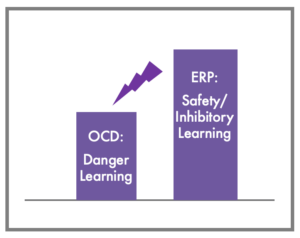 While this sounds simple, it’s not. Have you ever noticed that sometimes when you think about doing ERP, suddenly all sorts of other activities become enticing, such as cleaning the entire house, replying to every email anyone has ever sent you, or even scheduling that dental procedure you’ve been putting off? Doing ERP often doesn’t seem like all that much fun, which means sometimes it doesn’t get done. Which can also mean that your OCD recovery can slow down or sometimes even grind to a halt.
While this sounds simple, it’s not. Have you ever noticed that sometimes when you think about doing ERP, suddenly all sorts of other activities become enticing, such as cleaning the entire house, replying to every email anyone has ever sent you, or even scheduling that dental procedure you’ve been putting off? Doing ERP often doesn’t seem like all that much fun, which means sometimes it doesn’t get done. Which can also mean that your OCD recovery can slow down or sometimes even grind to a halt.
But what if you knew exactly why doing your ERP homework was so important? What if you understood how it was helping you take back your life? Then doing your ERP exercises would seem a lot more motivating, which is what this blog post is all about!
Danger Learning
Let’s say that you were in the back of a convenience store standing in front of the coolers full of drinks deciding what kind of an afternoon pick-me-up you wanted to buy, when all of a sudden a guy saunters into the store, sticks a pistol in the face of the clerk, and shouts “give me all your money!” You turn and watch two of the other customers dive toward the robber, and in the tussle that ensues, shots are fired, a few people are injured, and the robber flees the scene of the crime.
Getting a drink is now the last thing on your mind. You only want to get out of the convenience store ASAP, and as you do, you vow to never go back there for the rest of your life.
The experience you just lived through taught your brain some danger learning. Danger learning occurs whenever you’re in a threatening situation (or one your brain perceives to be threatening) and has the following characteristics:
- It’s immediate. The moment the guy pulled the gun out, your brain initiated the fight-or-flight response and put a sticky note labeled “BAD” on everything associated with this convenience store, since it’s a place where clearly you could get killed.
- It generalizes. It’s not only unlikely you’ll want to come back to this convenience store anytime soon, but it’s also likely that you’ll be suspicious of any convenience store in the near future. You’ll perhaps even hesitate before stepping into places that look like convenience stores, such as drug stores or the grocery store. Danger learning generalizes because your brain’s #1 job is to keep you alive, and it’s now very skeptical of anything that resembles the convenience store where your life was threatened.
- It’s long-lasting. Your brain holds onto danger learning because that’s part of how it keeps you safe. If you’re a hunter-gatherer and you forget that your cousin was eaten by a lion in the valley where the good berries are, then you’ll be likely to go gallivanting down to that berry patch unaware that a lion is putting on a bib and grabbing his silverware because a tasty morsel (YOU) has shown up just in time for his afternoon snack!
OCD is a type of danger learning because your brain is perceiving the content of the obsessions to be threatening. When OCD is active, your brain is reacting negatively to obsessions, you feel anxious much of the time, and life isn’t very much fun.
Safety/Inhibitory Learning
On the other hand, there’s safety learning (also known as inhibitory learning, which I’ll explain below). Let’s say a friend of yours, Olivia, is afraid of dogs and does compulsive behaviors such as shrieking and hiding behind anyone near her whenever she sees a dog. How would you help her overcome her fear?
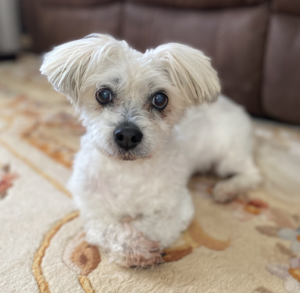 Well, first you’d probably show her some pictures and videos of really cute dogs from social media. Then you might suggest that she meet this adorable little eight-pound fluffy ball of a dog whose name is Lovey because he’s so loving. Olivia meets Lovey and it goes well! So is she over her dog phobia? No, and that’s because the characteristics of safety learning are the opposite of those of danger learning:
Well, first you’d probably show her some pictures and videos of really cute dogs from social media. Then you might suggest that she meet this adorable little eight-pound fluffy ball of a dog whose name is Lovey because he’s so loving. Olivia meets Lovey and it goes well! So is she over her dog phobia? No, and that’s because the characteristics of safety learning are the opposite of those of danger learning:
- It takes a while. Again, our brains’ #1 job is to keep us alive, so Olivia’s brain is not going to drop its guard after one cute dog and say that all dogs are fine. Her brain is hesitant. Suspicious. Cautious. Because the way her brain sees it, if it makes a mistake and drops its hypervigiliance around dogs, Olivia could get hurt. It’s likely only going to be convinced after many, many encounters with dogs that perhaps most dogs are friendly and loving.
- It’s specific. Olivia meets Lovey and it went well, but what Olivia’s brain learned is that Lovey is probably not a risk. Not that all small dogs are fine or that all dogs like look like fluff balls are fine, but that Lovey specifically is probably okay. As Olivia meets more and more dogs and the encounters go well, her brain will keep a mental list of all the specific dogs that seem to be okay. Eventually, after lots of practice, the learning will start to generalize, but when Olivia is getting started, it’s a dog-by-dog process.
- It’s short term, unless you practice a lot. Let’s say Olivia met tons of dogs and managed to learn that most dogs are friendly. Then, let’s say that Olivia goes overseas for six months and doesn’t see any dogs while she’s away. When she comes back, is she going to feel totally comfortable around dogs? Probably not, as she hasn’t practiced being around dogs, and without practice, her brain is likely to revert back to what it thinks will keep her alive, i.e., that it’s best to treat dogs with caution.
Even though we call this type of learning “safety learning,” it’s important to note that it’s not proving that things are definitely safe. Because, for Olivia’s example, not all dogs are safe! What Olivia is learning instead is that she can tolerate the uncertainty of not knowing how a dog is going to react to her while not doing her compulsive behaviors.
Exposure and response prevention therapy for OCD builds safety learning. With ERP, we’re learning that we can tolerate the uncertainty of not knowing whether the “what if?” obsession is true. And in fact, we’re aiming for that “what if?” to not even be a question worth answering or paying attention to going forward! Another term for safety learning is inhibitory learning because the more safety learning you build, the more it inhibits the danger learning. When the danger learning is inhibited, that means your brain isn’t listening to it as much (or at all), meaning you get to focus on things that interest and matter to you, not what OCD cares about.
Why ERP Homework Matters
Before you start ERP therapy, you probably have a fair amount of OCD/danger learning and maybe just a little bit of safety learning (if any at all). At this point, your brain is listening to the danger learning and you probably have your own version of WDNG playing in your head:
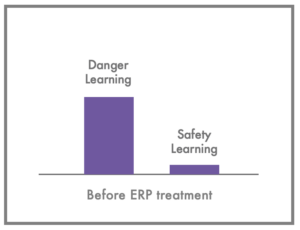
When you do start ERP therapy and begin doing your daily ERP homework, however, you notice that things start to change. You start building up the level of safety learning in your brain, and the volume on WDNG eventually starts to go down:
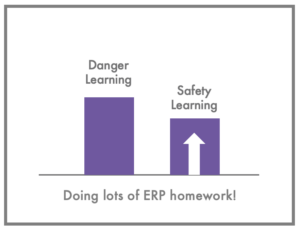
But then let’s say that your OCD starts convincing you that ERP is too hard, too risky, and/or too scary, or it tells you that you don’t actually need to do as much ERP because you’re doing so much better, and you start falling off the job when it comes to doing your ERP homework. Now we have a situation where sometimes your safety learning is building (when you’re doing your ERP homework consistently), and sometimes it’s actually falling (when you’re not doing your homework and instead doing compulsions), and you end up with a lower level of safety learning than you had before and a bit higher volume on WDNG:
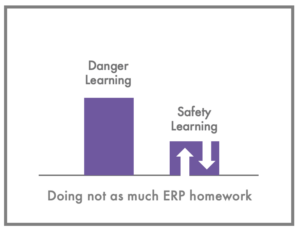
But then you remember that you want to reclaim your life, even though it takes a lot of hard work, and you recommit to doing your ERP homework consistently, and your level of safety learning starts to improve and WDNG once again starts to get quieter:

You keep up your consistent effort, being self-compassionate about the fact that you aren’t going to perfectly do your ERP (but we wouldn’t want to do perfect ERP, because that would be doing ERP in an OCD way!), and you keep putting in the work. Sometimes you win, and every now and then OCD gets the better of you, but that’s okay, because you keep going with your ERP, working with your OCD therapist to troubleshoot issues along the way. And you gradually start to notice that WDNG is getting much, much quieter, and some days you don’t even hear it at all:
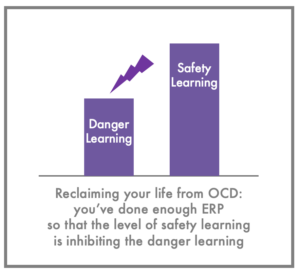
And this is when you realize that you’re starting to build the level of safety learning higher than the danger learning! And you work with your therapist to put together a relapse prevention plan to maintain your safety/inhibitory learning so you can keep your life your own!
Learn more about taming OCD
To learn more about how I used ERP to turn down the volume on WDNG, read or listen to Is Fred in the Refrigerator? Taming OCD and Reclaiming My Life. Click here to purchase a copy.
Sign up for my Shoulders Back! newsletter to receive OCD-taming tips & resources, including notifications of new blog posts, delivered every month to your inbox.
My blogs are not a replacement for therapy, and I encourage all readers who have obsessive compulsive disorder to find a competent ERP therapist. See the IOCDF treatment provider database for a provider near you. And never give up hope, because you can tame OCD and reclaim your life!


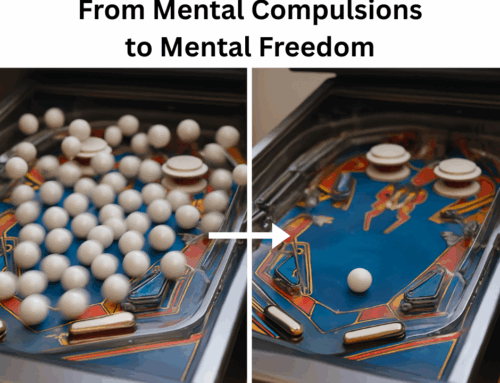

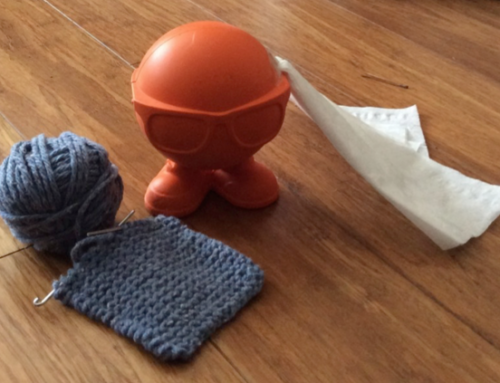


Very helpful on the ‘why’ behind ERP. As someone who first did ERP many years ago – and has this year had quite a significant moment by publishing a novel inspired by my experiences with OCD – this is a great reminder that managing OCD is an ongoing process. We can continue to build that safety learning throughout our lives. Thank you.
Great info! What does WDNG stand for? I’ve seen you use this in other writings as well. Thanks for all you do for the OCD/anxiety community!
Glad you found it helpfu! WDNG is the broadcast call sign for “my own private radio permanently tuned to the danger station:” W-DaNGer. 🙂
Brilliant article, thank you for this Shala
Thanks so much, Shala! I can’t tell you how empowering all your Infos are.
I have one question, that I am wondering about (and maybe a bit obsessing): what if I can’t really plan exposures as my thoughts & feelings usually appear followed by spontaneous triggers (sudden symptom as a sign for cancer)? And that makes it very hard for me to establish a fear hierarchy.
Many thanks for your help and your outstanding helpful blogs.
I’m so glad they are helpful! Check out Proactive vs. reactive ERP in https://www.shalanicely.com/aha-moments/the-anatomy-of-erp-for-ocd/ in response to your question!